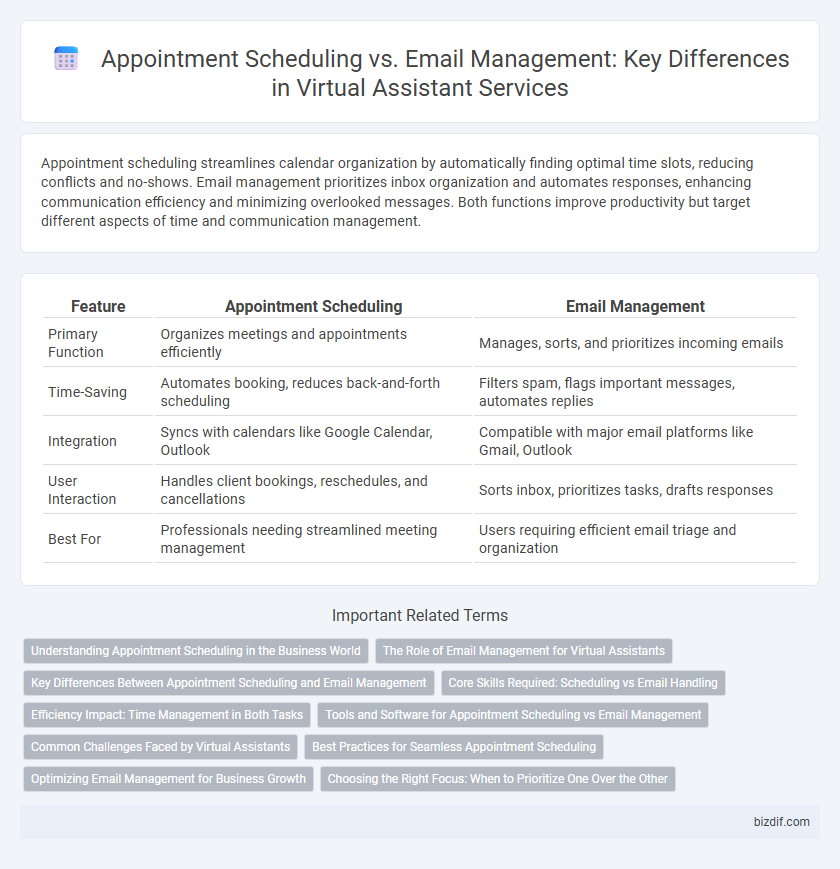Appointment scheduling streamlines calendar organization by automatically finding optimal time slots, reducing conflicts and no-shows. Email management prioritizes inbox organization and automates responses, enhancing communication efficiency and minimizing overlooked messages. Both functions improve productivity but target different aspects of time and communication management.
Table of Comparison
| Feature | Appointment Scheduling | Email Management |
|---|---|---|
| Primary Function | Organizes meetings and appointments efficiently | Manages, sorts, and prioritizes incoming emails |
| Time-Saving | Automates booking, reduces back-and-forth scheduling | Filters spam, flags important messages, automates replies |
| Integration | Syncs with calendars like Google Calendar, Outlook | Compatible with major email platforms like Gmail, Outlook |
| User Interaction | Handles client bookings, reschedules, and cancellations | Sorts inbox, prioritizes tasks, drafts responses |
| Best For | Professionals needing streamlined meeting management | Users requiring efficient email triage and organization |
Understanding Appointment Scheduling in the Business World
Appointment scheduling in the business world streamlines client interactions by automating calendar management and reducing no-shows through timely reminders. Advanced virtual assistants integrate with multiple platforms, enabling seamless coordination across time zones and team members. Efficient scheduling boosts productivity by prioritizing meetings that align with strategic goals, unlike email management which primarily focuses on communication filtering and response organization.
The Role of Email Management for Virtual Assistants
Email management is a core function of virtual assistants, ensuring efficient organization, timely responses, and prioritization of incoming messages to enhance productivity. Unlike appointment scheduling, which requires precise calendar coordination, email management demands effective filtering, categorization, and follow-up tracking to prevent missed communications. Mastery in email management allows virtual assistants to streamline workflows, improve client communication, and reduce response times significantly.
Key Differences Between Appointment Scheduling and Email Management
Appointment scheduling involves organizing and managing calendars to set up meetings or events efficiently, whereas email management focuses on handling incoming and outgoing messages to maintain clear communication. Scheduling emphasizes time-blocking and availability coordination, while email management prioritizes inbox organization, message prioritization, and response tracking. Virtual assistants specializing in appointment scheduling streamline calendar conflicts and reminders, whereas those skilled in email management enhance productivity through spam filtering and effective information categorization.
Core Skills Required: Scheduling vs Email Handling
Effective appointment scheduling demands strong organizational skills, time management, and proficiency with calendar software like Google Calendar or Microsoft Outlook. Email management requires expertise in written communication, prioritization, and familiarity with email platforms such as Gmail or Outlook, as well as techniques for handling spam, filtering, and follow-ups. Virtual assistants skilled in scheduling excel at coordinating multiple calendars and reminders, while those adept in email handling streamline inbox organization and ensure timely responses.
Efficiency Impact: Time Management in Both Tasks
Appointment scheduling streamlines time management by automating calendar coordination and minimizing back-and-forth communication, allowing virtual assistants to optimize availability and reduce scheduling conflicts. Email management enhances efficiency through inbox organization, prioritization, and timely responses, preventing task overload and improving workflow continuity. Combining both tasks effectively maximizes productivity by balancing proactive time allocation with responsive communication control.
Tools and Software for Appointment Scheduling vs Email Management
Top tools for appointment scheduling include Calendly, Acuity Scheduling, and Doodle, which offer automated calendar integration, real-time availability updates, and seamless client booking. Email management utilizes platforms like Microsoft Outlook, Gmail with tools such as Boomerang and SaneBox, enabling efficient inbox organization, email filtering, and follow-up tracking. Integration of these specialized software enhances productivity by streamlining scheduling workflows and maintaining effective communication.
Common Challenges Faced by Virtual Assistants
Virtual assistants often struggle with balancing appointment scheduling and email management due to the high volume of tasks and urgent deadlines. Scheduling conflicts and overlapping meetings frequently disrupt workflow, while managing overflowing inboxes requires prioritization of critical messages without overlooking any important correspondence. Efficiently handling these challenges demands advanced organizational skills and proficiency with digital tools to maintain seamless communication and time management.
Best Practices for Seamless Appointment Scheduling
Effective appointment scheduling requires using integrated calendar systems like Google Calendar or Outlook to avoid double bookings and ensure real-time updates. Implementing automated reminders via SMS or email reduces no-shows and enhances client punctuality. Streamlining appointment booking interfaces with clear time slots and confirmation protocols optimizes user experience and operational efficiency.
Optimizing Email Management for Business Growth
Optimizing email management enhances business growth by streamlining communication and prioritizing critical messages, reducing response times significantly. Advanced virtual assistants use AI algorithms to categorize, flag, and automate responses, increasing operational efficiency and allowing teams to focus on strategic tasks. Efficient email handling minimizes missed opportunities and fosters better client relationships, directly impacting revenue and productivity.
Choosing the Right Focus: When to Prioritize One Over the Other
Appointment scheduling demands precise time management and real-time calendar coordination to ensure seamless client interactions, while email management requires effective sorting, prioritization, and timely responses to maintain clear communication channels. Prioritize appointment scheduling when deadlines and client meetings drive business operations, ensuring punctuality and availability; shift focus to email management during high volumes of correspondence that impact decision-making and customer satisfaction. Understanding the business's immediate goals and workflow complexities helps determine whether controlling the calendar or managing communication will maximize productivity and efficiency.
Appointment scheduling vs Email management Infographic

 bizdif.com
bizdif.com